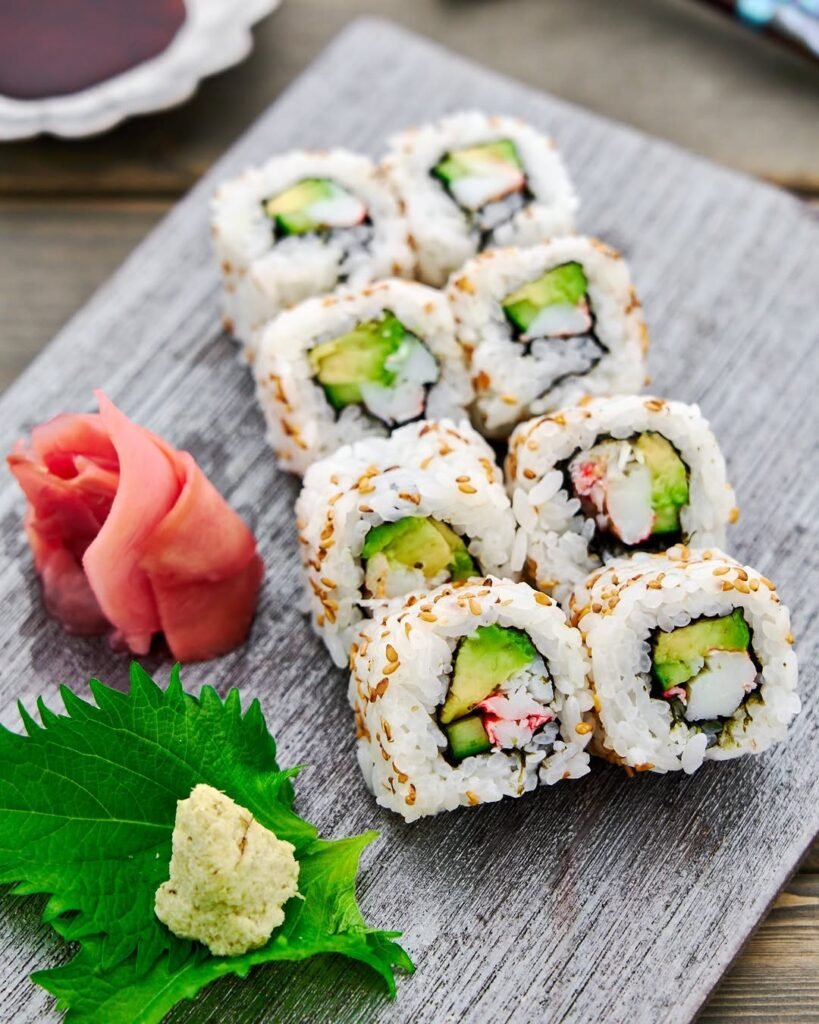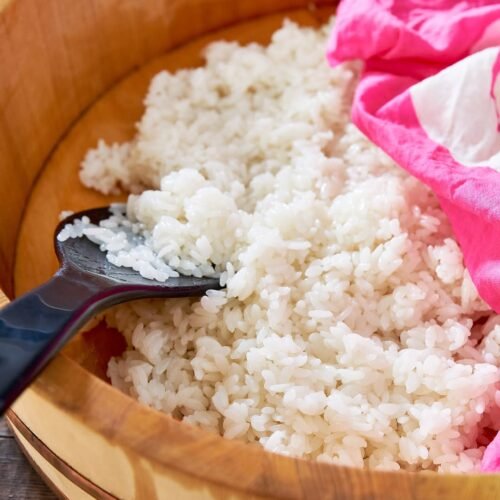Sushi Rice Recipe – When making sushi, short-grain rice called sushi rice is used. It features soft ingredients, is not too salty, and is mixed with rice vinegar, sugar, and salt. When it comes out of the pot, the rice is cooled and stirred in the vinegar mixture for a light, tangy, and sweetened taste. By using this seasoning, the rice stays joined, important when we make rolls or nigiri.

Many tasty dishes in Japanese cuisine begin with good sushi rice. It’s an easy ingredient to make yourself and provides a delicious taste and a unique texture to your sushi.
Sushi Rice Recipe
Almost every sushi dish centers on sushi rice, which adds great taste and texture to the meal. Significant ingredients in a sushi rice recipe are Japanese short-grain rice and a mix of rice vinegar, sugar, and salt to make soft, flavorful sushi rice. This guide explains how to prepare sushi rice correctly, so your own sushi tastes just like the professionals serve it.
If you want to make great sushi, you should learn how to cook sushi rice, regardless of your skills.

Sushi Rice Recipe
Equipment
- 1 Medium saucepan with a lid
- 1 Wooden spoon or rice paddle
- 1 Large shallow bow
- 1 Small saucepan
- 1 Fine-mesh sieve
- 1 Measuring cups and spoons
- 1 Kitchen towel
Ingredients
For the Rice:
- 2 cups Japanese short-grain rice
- 2 ½ cups water
For the Seasoning:
- ¼ cup rice vinegar
- 2 tbsp granulated sugar
- 1 tbsp salt
Instructions
- rinse your rice:Measure 2 cups of sushi rice and put it in a sieve.Cold water should be run over the rice as you gently stir it for the water to become clear.Following this step takes out extra starch which helps rice avoid getting stuck together.
- soak your rice:After washing the rice, add it to a medium saucepan (or place it in a rice cooker) and add 2 ½ cups of water.Give your rice at least 30 minutes to soak. At this point, the rice gets an even cook.
- cook the rice.For a saucepan: Add the rice and water, turn on medium heat and let it boil. When the water comes to a boil, change the heat, cover with a lid and cook for 15 minutes.Remove the heat and let the rice be covered for ten minutes.Read the manual or use the instructions that come with the rice cooker.
- Get your seasoning ready:In a small saucepan, put in ¼ cup rice vinegar, 2 tablespoons sugar and 1 teaspoon salt.Heat the sugar, salt and water over low heat and stir frequently until everything dissolves. Do not let it come to a boil. Get the pan off the heat and let it cool slightly.
- Fry together the Rice and Seasoning:Put the cooked rice into a big, flat bowl. Spread the rice throughout the tray by using a wooden spoon or rice paddle.Sprinkle the rice library with vinegar mixture until all the rice is covered.Mix the rice and seasoning gently with a knife, keeping the rice from getting mashed.
- After cooking, your rice should be dried and left to cool naturally.Make sure the mixture is cooled to room temperature after you mix it. With the dish covered in a damp kitchen towel, it will stay moist.
- Fiasko: Usa riceYou can now use your sushi rice for rolling up maki, making nigiri or other kinds of sushi.
Notes
Sushi Rice Nutrition
| Nutrient | Amount |
| Calories | 200 kcal |
| Carbohydrates | 45 g |
| Protein | 4 g |
| Fat | 0 g |
| Fiber | 1 g |
| Sodium | 300 mg |
| Sugars | 2 g |
Flavour Profile of Sushi Rice Recipe
1. Slightly Sweet
- The sweetness from the seasoning makes the rice go well with the freshly flavored ingredients of sushi.
2. Mildly Tangy
- Adding rice vinegar makes the dish sweeter and gives nice flavor.
3. Umami-Rich
- Combining rice, vinegar, and salt to make Koshihikari rice gives it a wonderful savory flavor, so you can enjoy it without needing to add anything else.
4. Evenly Light
- Flavors in sushi are mellow and well-balanced, so they do not take away from what’s inside or on top.
5. Texturally, It’s Slightly Clingy
- It has a texture that makes it ideal for holding sushi rolls or nigiri—it’s both soft, sticky, and chewy just a little.
FAQs
Q. Is It OK to Put Any Kind of Rice in Sushi?
A. Only Japanese short-grain rice can be used for sushi rice. Because it’s sticky and has the proper consistency, it keeps sushi rolls intact. Any other kind of rice, like long-grain or medium-grain, just won’t be as satisfying.
Q. Why Should I Wash My Rice?
A. Rinsing the rice takes off extra starch, so the dish doesn’t turn out sticky or gummy. It produces sushi rice that is just right in terms of texture.
Q. Is it okay if I don’t use the Vinegar Mixture?
A. You must use the vinegar mixture when making sushi rice. It adds a special taste and stops the rice from spoiling. The well-known sushi flavor would be missing if you didn’t use it in your recipe.
Q. How Should I Keep My Leftover Sushi Rice?
A. Sushi rice can stay at room temperature in an airtight container for up to 4 hours or in the refrigerator for a period of one day. Preheat the oven to 50 degrees and put the crust on top of a damp towel for 10 minutes.
Q. Can I Use My Prepared Sushi Rice for Anything Else?
A. You can use rice for sushi in rice bowls, poke bowls, or even make onigiri (rice balls). Because it tastes well with a variety of foods, it can be used for many dishes. These tips will show you how to prepare sushi rice that’s perfect for making sushi.

Hi, I’m Lauren Kossack — the recipe creator, food lover, and storyteller behind Perfect Meal Recipes! I’m based in the charming town of Zionsville, Indiana, where I share my passion for cooking simple, delicious, and family-friendly meals.
What started as a love for home-cooked comfort food has grown into a space where I create and collect the kinds of recipes that bring people together — whether it’s a quick weeknight dinner, a hearty sandwich, or a sweet weekend treat.

